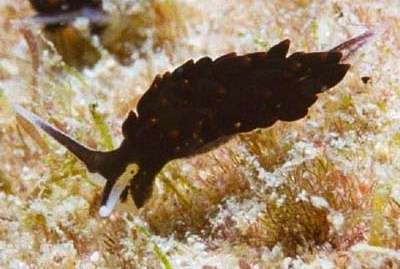
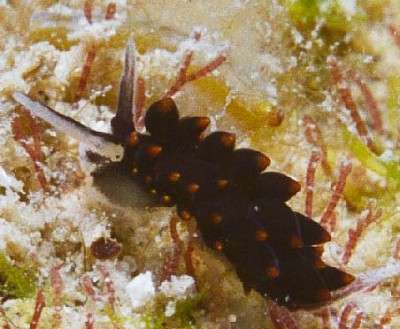
Ercolania boodleae
(Baba, 1938)
Order: SACOGLOSSA
Superfamily: LIMAPONTIOIDEA
Family: Limapontiidae
DISTRIBUTION
Throughout Japan from Hokkaido to Kyushu. Possibly also in Australia.
PHOTO
Japan (Kii Peninsula east coast), Depth: 3m, Length: 6mm. Jan. 2000. PHOTOS: Yasuhiro Shirai.
Whole upper body surface except for anterior edge of head, eye-regions and border of foot is black or heavily dusted with black specks. The tip of the rod-like rhinophores are whitish. The branchia papillae (cerata) are blackish with a yellowish-brown (or orange-brown) cap with white specks at the tip - In rare cases there is no brown pigmentation. The anterior end of the foot is rounded which differentitaes this species from Stiliger formicarius, a similar shaped and coloured sacoglossan. It is usually found in the upper levels of the intertidal zone on green algae, such as Cladophora, Enteromorpha, Boodlea and Ulva.
See Ercolania cf. boodleae from southern Australia which is almost certainly the same species.
References:
• Baba,K. (1938) Opisthobranchia of Kii, Middle Japan. Journal of the Department of Agriculture, Kyusyu Imperial University, 6(1): 1-19.
• Baba, K. & Hamatani, I. (1970) The anatomy of Ercolania boodleae (Baba, 1938) from Seto, Kii, Middle Japan (Opisthobranchia: Sacoglossa). Publications of the Seto Marine Biological Laboratory, 18(4):215-222.
Rudman, W.B., 2000 (February 11) Ercolania boodleae (Baba, 1938). [In] Sea Slug Forum. Australian Museum, Sydney. Available from http://www.seaslugforum.net/find/ercobood
Related messages
Pacific Russian Ercolania boodleae
April 14, 2005
From: A. V. Chernyshev & A.V. Ratnikov
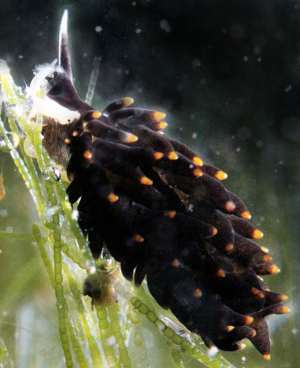
Dear Bill,
Ercolania boodleae is a common sacoglossan species in Peter the Great Bay (Russia, Sea of Japan) (Minichev, 1976). Alexander Martynov (1997) listed this species for the intertidal zone of the South Sakhalin (Sea of Okhotsk). We found E. boodleae on the different green algae (Ulva, Cladophora, Chaetomorpha etc.).
Locality: Peter the Great Bay, Russia, Sea of Japan. Depth: 1-2 m. Length: 10 mm. August 2001. on Chaetomorpha moniligera. Photographer: Alexander V. Ratnikov.
-
Martynov A.V. (1997) Subclassis Opisthobranchia. In: Kussakin O.G., Ivanova M.B., Tsurpalo A.P. et al. A check-list of animals, plants and fungi from the intertidal zone of Far Eastern seas of Russia. Vladivostok, Dalnauka: 77-80 (in Russian)
-
Minichev Yu.S. (1976) Subclass Opisthobranchia. Animals and plants of Peter the Great Bay. Leningrad, Nauka: 92-95 (in Russian)
Alexei V. Chernyshev & Alexander V. Ratnikov
Institute of Marine Biology, Vladivostok, Russia.
tsher@bio.dvgu.ru
Chernyshev, A.V. & Ratnikov, A.V., 2005 (Apr 14) Pacific Russian Ercolania boodleae . [Message in] Sea Slug Forum. Australian Museum, Sydney. Available from http://www.seaslugforum.net/find/13427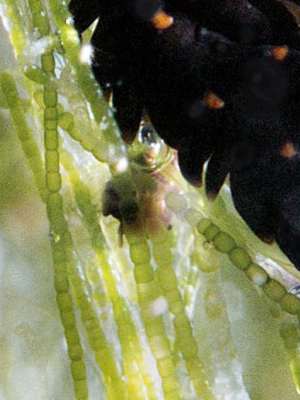
Thanks Alexei & Alexander,
It is good to get additional information on these species we previously only knew from Japan.
Best wishes,
Bill Rudman
Re: Ercolania boodleae? on Valonia
May 25, 2000
From: Kathe R. Jensen
Dear Bill,
Another sacoglossan message I missed during my first few weeks in Thailand. The photos make me 99% certain that the species I described as Ercolania emarginata from Hong Kong (in 1985) is identical to E. boodleaea. I was uncertain at the time. I dissected several specimens from Japan, and they differed very slightly by consistently. There is, however, another "sibling" species, as yet undescribed, in Hong Kong. I only noticed it the last time I went there. I was trying to do some copulation experiments, and couldn't understand why one specimen (with white rather than orange tips of cerata) was not interested at all - until it was placed with another specimen without the orange tips. The eggs also differed in size, so they must be different (if the old definition of a species as interbreeding populations is still valid).
Concerning its eating Valonia, there is no reason why it shouldn't. Valonia has the same cell wall structure as Chaetomorpha and Cladophora. It would be interesting to see if the radular teeth of Valonia-eating specimens are larger than those of animals feeding on filamentous algae.
Kathe
jensen@ait.ac.th
Jensen, K.R., 2000 (May 25) Re: Ercolania boodleae? on Valonia. [Message in] Sea Slug Forum. Australian Museum, Sydney. Available from http://www.seaslugforum.net/find/2441Thanks Kathe,
I am glad the Forum helped you to sort out some Hong Kong animals. This is why I am always asking for photos. It is so much help in identifying and comparing animals from different places.
Best wishes,
Bill Rudman.
Food of Ercolania boodleae
March 20, 2000
From: Yasuhiro Shirai
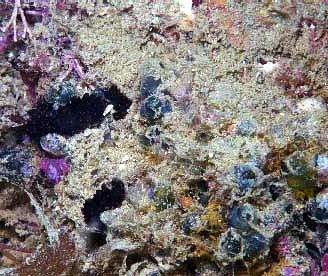
Dear Bill,
Thank you for your reply about Ercolania boodleae on Valonia.
Here is a photo of it with Valonia.
These animals (orange tips on their cerata) usually are on Valonia macrophysa.
And Valonia are worm-eaten gradually like this photo. I have often seen colonies of Valonia become gradually worm-eaten like this when Ercolania is present so I thought these animals eat Valonia macrophysa.
Best regards,
Yasuhiro Shirai
yasuhiro@e-net.or.jp
Shirai, Y., 2000 (Mar 20) Food of Ercolania boodleae. [Message in] Sea Slug Forum. Australian Museum, Sydney. Available from http://www.seaslugforum.net/find/2125Dear Yasuhiro,
Thanks for the photo. You may be right about them eating Valonia. All I know about Ercolania boodleae is what I have read in publications by Baba and Hamatani, where it is said that they feed on filamentous algae. Valonia quite often has a growth of filamentous algae over it so by grazing of this algal layer is certainly one way Ercolania could make Valonia look 'worm-eaten'. Feeding observations are always difficult. The only sure way is to watch a species actually feeding, but as we all know that is often easier said than done.
Best wishes,
Bill Rudman.
Ercolania boodleae? on Valonia
March 4, 2000
From: Yasuhiro Shirai
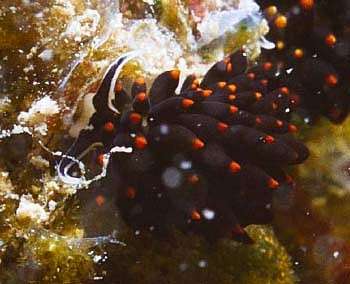
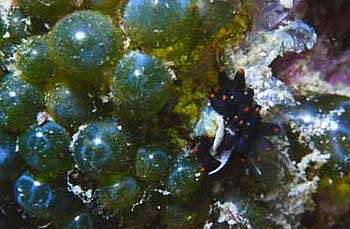
Dear Bill,
Thank you for your earlier replies.
This time, I attach 2 image files. I think these animals are similar to Ercolania boodleae.
Usually I find Ercolania boodleae, on rocks with algae or moss. But these animals are usually on seaweed (Valonia macrophysa). I think these animals eat Valonia macrophysa. When they are attacked, they cut off their cerata themselves.
Are they Ercolania boodleae?
Data:
Location: Shima Pref. Mie, Japan (Kii Peninsula, east coast)
Length: 5-15mm
Water temperature: 14C
Date Jan.2000 - Feb.2000
Depth: 2-5m
Crawling on seaweed (Valonia macrophysa).
Best regards,
Yasuhiro Shirai
yasuhiro@e-net.or.jp
Shirai, Y., 2000 (Mar 4) Ercolania boodleae? on Valonia. [Message in] Sea Slug Forum. Australian Museum, Sydney. Available from http://www.seaslugforum.net/find/2024Dear Yasuhiro,
I am pretty sure these are Ercolania boodleae. They look very similar to the paintings in Baba's Opisthobranchs of Sagami Bay. Baba & Hamatani (1970) state that this species is associated with green algae such as Chaetomorpha, Ulva, Enteromorpha, and Boodlea. I suspect your animals are not eating Valonia but feeding on tiny epiphytic filamentous green algae which grow on Valonia.
There is a very interesting sacoglossan that feeds on Valonia. Each 'bubble' of the algae is a giant cell and this sacoglossan is found inside the cell feeding on the cell contents. It has recently been named Ercolania endophytophaga by Kathe Jensen but is very difficult to find without collecting lots of Valonia and taking it back to the lab for examination.
Best wishes,
Bill Rudman.
Re: Ercolania boodleae from Japan
February 18, 2000
From: Yasuhiro Shirai

Dear Bill,
Thank you for your reply about my message. The attached photo was taken at the same time. They have the reddish brown tips on their cerata that you mentioned it should have.
Can you see in this photo?
Best regards
Yasuhiro Shirai
yasuhiro@e-net.or.jp
Shirai, Y., 2000 (Feb 18) Re: Ercolania boodleae from Japan. [Message in] Sea Slug Forum. Australian Museum, Sydney. Available from http://www.seaslugforum.net/find/1929Dear Yasuhiro,
Thanks for the extra photo, which seems to confirm that it is E. boodleae.
Best wishes,
Bill Rudman.
Ercolania boodleae? from Japan
February 14, 2000
From: Yasuhiro Shirai

Dear Bill,
Thank you for your quick reply.
I found this opisthobranch at Shima.
This opisthobranch crawled on rock with algae. Could you please identify this animal for me.
Data:
Location: Shima Pref. Mie Japan (Kii Peninsula east coast)
Length: 6mm
Water temperature: 13C
Date Jan. 2000
Depth: 3m
Crawling on rock
Best regards,
Yasuhiro Shirai
http://www.e-net.or.jp/user/yasuhiro/
yasuhiro@e-net.or.jp
Shirai, Y., 2000 (Feb 14) Ercolania boodleae? from Japan. [Message in] Sea Slug Forum. Australian Museum, Sydney. Available from http://www.seaslugforum.net/find/1889Dear Yasuhiro,
I think this animal is Ercolania boodleae but it would help to know something about the colour of the tips of the branchial papillae [cerata]. Are they reddish brown? It is not possible to see in your photo.
Many of these 'aeolid-like' sacoglossans are commonly found in the intertidal region, often quite high on the shore.
Best wishes,
Bill Rudman.
